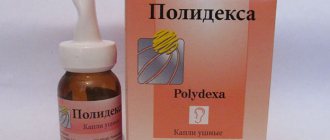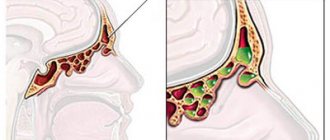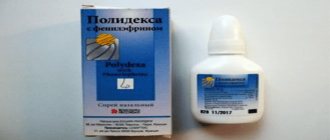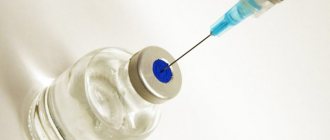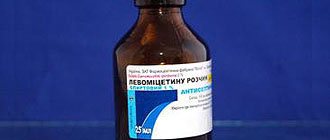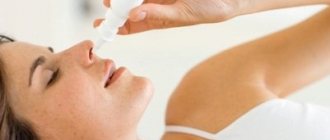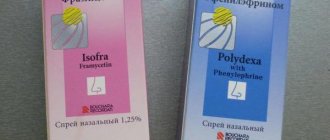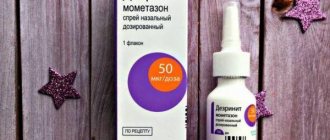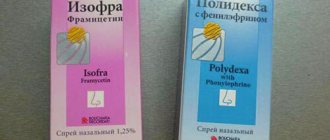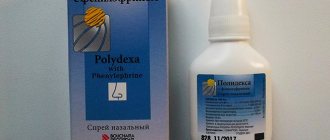Polydexa nasal spray is a complex drug that helps reduce mucus secretion from the nose. It has antibacterial, vasoconstrictor and antihistamine effects. Therefore, the composition contains several active ingredients at once.
This is what determines its effectiveness. The drug is intended for the treatment of purulent-inflammatory diseases of the nose. Despite the complex composition, which scares the antibacterial and hormonal components, reviews about it are positive.
Composition and pharmacological action of the drug
Polydex aerosol is produced in France and is available in 15 ml spray bottles. This topical remedy is often prescribed in otolaryngological practice. The composition of the drug is represented by four components: neomycin, polymyxin B, dexamethasone, phenylephrine.
The vasoconstrictor effect and, as a result, relief of nasal breathing is achieved through phenylephrine. This substance is of organic origin and is synthesized artificially. It acts on the alpha-adrenergic receptors of the parasympathetic nervous system and thereby causes a narrowing of small arteries and capillaries in the nasal mucosa.
In addition to the vasoconstrictor effect, it leads to thickening of the walls of blood vessels and increases their tone. Due to this, free nasal breathing is restored and mucus secretion in the nasal passages is reduced. Dexamethasone in the spray, being a synthetic glucocorticosteroid, provides an anti-inflammatory effect, eliminates irritation and itching.
Neomycin and polymyxin B are the antibacterial components of the drug. It is thanks to them that pathogenic microorganisms that cause the development of infectious inflammation are destroyed. The combination of these antibacterial components makes it possible to act on most gram-negative and gram-positive bacteria that cause inflammatory diseases of the paranasal sinuses and nasal cavity.
Neomycin belongs to the antibacterial drugs of the aminoglycoside group. It has a bactericidal effect and is effective against aerobic and anaerobic microorganisms, such as Escherichia coli, staphylococcus, Klebsiella, Pseudomonas aeruginosa and Haemophilus influenzae. However, it is not able to act on pneumococci and streptococci. Polymyxin enhances the effect of neomycin on pathogenic microorganisms and, due to it, the spectrum of action of the latter expands.
In particular, this combination is capable of eliminating Staphylococcus aureus, which is considered the main provocateur of complications of otolaryngological diseases.
This complex drug has a triple effect
https://youtu.be/https://www.youtube.com/watch?v=kSZZVWucCq0
_
How long is the drug good for in a closed package and after opening?
In the form of ear drops
Reference. The drug Polidex is available in 10.5 ml dark glass bottles with a dosage pipette. Since the original drug Polidex contains antibiotics and a glucocorticosteroid, it has certain storage conditions.
- In closed packaging, the drug is stored at a temperature not exceeding 25 degrees Celsius. At humidity no more than 70%. The shelf life of the drug is 3 years.
- After opening the package, the drug can be used effectively for no more than 3-4 weeks.
As a nasal spray
Medicine: Polydexa with phenylephrine, released by the same French company in 2008, has a similar composition, but in addition to glucocorticosteroids and antibiotics, it also contains a vasoconstrictor: phenylephrine. This is why it is effective against rhinitis and sinusitis.
- In closed packaging, the drug is stored at a temperature not exceeding 25 degrees Celsius.
At humidity no more than 70%. Shelf life is three years. Polydex nasal spray with phenylephrine is listed B. - After opening the package, Polydex nasal spray with phenylephrine can be used for 1 month.
Indications and method of use
Polydex nasal spray is prescribed for the treatment of inflammatory and infectious diseases of the nose and paranasal sinuses. These include:
- acute or chronic nasopharyngitis - inflammation of the nasal mucosa affecting the pharynx;
- rhinitis, including purulent;
- adenoiditis - inflammation of the pharyngeal tonsils;
- sinusitis - inflammation of the nasal sinuses;
- frontal sinusitis - inflammation of the mucous membrane of the frontal sinus;
- ethmoiditis - inflammation of the cells of the ethmoid labyrinth.
Regarding dosage, the instructions are as follows: 1 injection into each nostril 3-5 times a day for adults. For children over 2.5 years old and under 15 years old – 3 times a day, 1 injection into each nasal opening. The duration of treatment is determined by the attending physician, usually from 5 to 10 days.
Since Polydex spray is not absorbed into the blood, there is no possibility of overdose. But it is necessary to ensure that the medicine is out of the child’s reach, since if it gets inside, you will need to rinse the stomach and call a doctor.
Contraindications for use
The use of Polydex drops is contraindicated in several pathological conditions of the body, which include:
- Hypersensitivity to neomycin (including other aminoglycoside antibiotics), polymyxin B, dexamethasone or auxiliary components of the drug.
- Traumatic or infectious perforation (formation of a through hole) of the eardrum or suspicion of its development.
- Viral infections of the external auditory canal or middle ear (herpes virus or herpes zoster), in which the use of dexamethasone, which is part of the drug, can provoke additional activation of viruses.
Polydex drops should be used with caution during pregnancy or breastfeeding. Before starting to use the drug, you should make sure that there are no contraindications.
Contraindications and side effects
The instructions for use indicate that Polydexa has a number of contraindications and is not indicated:
- during pregnancy and breastfeeding;
- viral diseases;
- children under 2.5 years of age;
- manifestation of individual intolerance to the components of the drug;
- angle-closure glaucoma;
- severe kidney diseases.
Polydexa is not intended for rinsing the sinuses. Patients with hyperthyroidism, arterial hypertension and coronary heart disease should use the drug with caution and under the supervision of a physician. The drug is well tolerated, and side effects when taking it are extremely rare. This can only be an allergic reaction in the form of skin urticaria.
Polydex spray has contraindications
Composition, indications for use and contraindications
Pharmacists offer the following types of medicine depending on its use:
- Nasal Polydexa in the form of a bottle with a spray for ease of use;
- Ear drops in a package with the same picture as on the spray. Used for otitis media.
The composition of the drug depends on the method of its use. The active ingredient is a combination, so this medicine is more effective than many other drugs.
The nasal spray includes:
- Dexamethasone has an anti-inflammatory effect;
- Neomycin is an antibiotic and therefore has an antibacterial effect;
- Polymyxin B is also an antibiotic;
- Phenylephrine is a vasoconstrictor.
Phenylephrine is not included in the ear drop solution.
Neomycin Dexamethasone Polymyxin B Phenylephrine
When a question arises about a drug: is it an antibiotic or not, its composition gives an accurate answer.
The instructions list the indications for use for the nasal spray:
- Purulent rhinitis, including in children;
- Sinusitis, sinusitis, sinusitis;
- Rhinopharyngitis;
- Chronic adenoiditis;
- After surgical operations on the nasopharynx.
If you have congestion or allergic rhinitis, nasal drops should not be used.
Polydexa has contraindications, the main of which are:
- Sensitivity to substances included in the medicine (allergies);
- Angle-closure glaucoma;
- Concomitant use of MAO inhibitors;
- Kidney diseases, for example, patients with pyelonephritis.
Instructions for use of Polydex contain instructions from what age a child should use the medicine, as well as the recommended dosage for a runny nose.
Possible side effects are listed, manifested in the form of cough, skin itching, rashes, which are somewhat less for drops in the ears due to the different content of active substances.
It is recommended to comply with the storage conditions and location.
The drug should be stored at a temperature not exceeding 25°C, in a dark place, away from children. The shelf life is 3 years from the date of its production.
to the antibiotic content in the drug, use is not recommended during pregnancy and lactation
Overdose in patients using Polydexa was not observed due to poor absorption of drugs into the blood.
The price of a package of the drug depends on the type of its action. Nasal Polydex with phenylephrine costs about 400 rubles. The price of ear drops is lower and amounts to 300 rubles per package.
Features of interaction with other drugs
Before using Polydex spray, you must tell your doctor about the medications that the patient needs to take for one reason or another. This is important, since the content of phenylephrine and dexamethasone in the spray in question can cause an undesirable reaction of the body when combined with certain drugs. So, there are 2 categories: unacceptable combinations of drugs and those requiring careful use.
It is strictly prohibited to combine Polydexa with phenylephrine with drugs such as:
- Bromocriptine. May cause vasospasm and increased blood pressure.
- Guanethidine. Arterial hypertension and dilated pupils for a long time are possible.
- Cyclopropane and Halothane. The risk of ventricular fibrillation increases.
- Monoamine oxidase inhibitors. The development of a hypertensive crisis and arterial hypertension is possible.
Caution should be exercised when prescribing Polydexa together with taking selective MAO inhibitors such as Moclobemide or Toloxatone. It is not advisable to combine the spray with taking aspirin and antiarrhythmic drugs. Polydex is not prescribed along with live vaccines (poliomyelitis and BCG).
Isofra nasal drops for children
Polydex nasal drops have analogues. These are drugs with a similar mechanism of action and composition. These include:
- Isofra;
- Mupirocin;
- Rinil;
- Bactroban;
- Fusafungin;
- Bioparox.
All of these drugs differ in cost, composition and manufacturer. But none of them contains simultaneously antibacterial, anti-inflammatory and vasoconstrictor components. The use of analogues requires the additional administration of vasoconstrictors.
If it is impossible to be treated with Polydex spray, you can choose an approximate replacement
Reviews
Irina, 42 years old, St. Petersburg: For the treatment of sinusitis, the doctor prescribed Polydex spray. Thanks to the complex composition, everything is included in one drug, and there is no need to take separate vasoconstrictor drops or a local antibiotic. After just one application, the condition improved significantly. I can confidently recommend this drug.
Sergey, 35 years old, Moscow: The autumn-winter cold season and exacerbation of a chronic nasal disease led to my acquaintance with Polydex nasal spray. The drug does not belong to the cheap category, but it pays off with its effectiveness. I felt its therapeutic effect almost immediately after use. And after a few days I forgot about the symptoms of the disease.
Svetlana, 29 years old, Tomsk: Ignoring my runny nose resulted in a bacterial complication. The doctor prescribed Polydexa in combination with Sinupret. I would like to note not only the quick effect of treatment with this spray, but also the ease of use of the bottle. Now this medicine will always be in my medicine cabinet.
